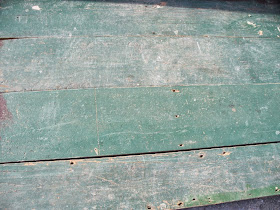IS IT "COLONIAL BALONIAL"? TEN WORDS BEST NOT
USED
In the last quarter of the nineteenth century following the
Centennial of 1876 there arose a renewed interest in the past. Some of
this was a reaction to the sometimes "over the top" Victorian taste
but also inspired by the one hundredth celebration of our independence.There was a renewed interest in the styles and object from the past.
There was also a new group of historians immersed in this trend.
Not having the sources we have for reference they invented words and
promoted the trend toward Colonial Revival. Now, one hundred and thirty
plus years later. some of these quaint terms have become part of our vocabulary,
right or wrong. Here are some of the most offending terms to avoid.
There are many more but let's start with ten.
1. BORNING ROOM A
small room off the kitchen reserved for childbirth.
 |
| Plan of 18th century house showing first floor bedroom. |
FACT: A first floor bedroom located off the kitchen for the convenience of anyone in the house
needing warmth, supervision, or unable to climb the stairs.
2. MORTGAGE BUTTON An ivory
decoration on the top of the newel post in the front stair hall capping a
hollowed out cylinder in which the paid off mortgage or deeds were secreted.
 |
| Ivory button in middle of newel post for decoration. |
3. KEEPING ROOM The colonial kitchen.
 |
| This is a typical kitchen with cooking fireplace, not a keeping room. |
FACT: A word not used in colonial New England . In old documents that room is simply called
the "kitchen".
FACT: Tories needed, by necessity, to be inconspicuous. The painted
chimney is a 20th century decoration.
5. DUTCH OVEN: The brick
oven built into the fireplace.
 |
| A modern Dutch oven or iron pot being used in a modern fireplace in the traditional manner. |
FACT; A dutch oven is a pot used for cooking on the hearth and has
nothing to do with the construction of the fireplace or bake oven.
5. WIDOWS' WALKS" A
rooftop perch from which the wife would scan the horizon for a glimpse of her
husband's ship returning from a voyage.
 |
| This is a widows walk, an open deck on the top of the house. |
6. KING BOARDS: Boards
intended for the king because of their size and used illegally by housewrights.
 |
| People are fascinated by the story of wide boards being illegal. Owners of old houses think they have illegal floors! |
FACT: The widest boards were used like plywood would be used today
to cover a large space
quickly. They were used for attic floors and
sheathing. There is a kernel of truth here. The king's men did select
the best trees they could find for masts
for the English Navy.
7. INDIAN SHUTTERS: Wooden
interior shutters used for protection from Indians.
8. SHIP CARPENTERS: Shipbuilders
who built houses in the winter or carved woodwork on shipboard
FACT: Houses were built by housewrights. Slanting floors, doors and windows are due to rotted sills. Houses were not deliberately built crooked so that the captain would feel comfortable
on land.
9. HL HINGES In
religious New England HL stands for "Holy Lord".
FACT: The HL hinge is simply the usual "H" hinge with an extra leg for supporting heavier doors
10. FEDERALIST: A three story house or captain's
house from about 1800 such as those on Chestnut Street Salem or n High Street in Newburyport , Portsmouth
 |
| A typical New England two story house from the Federal period, circa 1800 |





Prue teaches you things that you never knew, & you learn quite a bit from a teacher like her.
ReplyDeleteIf I hear someone say "borning room" one more time ...I will scream at them!! So happy you are talking about these silly terms!!
ReplyDeleteI'm not familiar with the houses of New England, so everything you are writing is incredibly interesting to me. thanks! - Kay from Oregon
ReplyDeleteNice articles always attract the viewers. And your article is very attractive and informative. Keep it up and do post regularly please…
ReplyDeleteCustom Faux Wood Shutters
So why white chimney with black top?
ReplyDeleteSo why white chimney with black top?
ReplyDelete